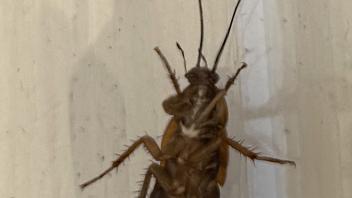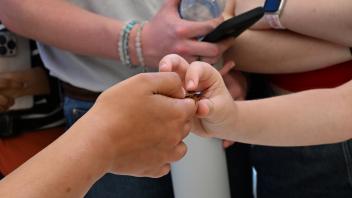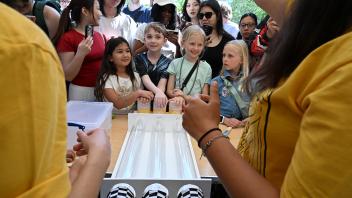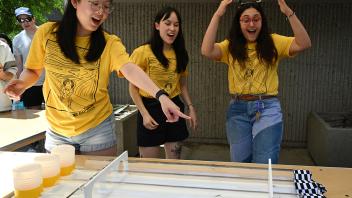Run, roaches, run!
The annual campuswide UC Davis Picnic Day wouldn't be the special event that it is without the Roach Races hosted by the Entomology Graduate Student Association (EGSA).
The roaches, reared in a UC Davis research lab, race in a specially made racetrack in front of Briggs Hall.
It works like this: an emcee, aka race director, holds a cockroach up, and asks for volunteers to name the athlete (it could be named for a professor, a colleague, a friend, an enemy, or a bystander).
And then "Who wants to pet the roach?"
Once the "formalities" are over, the athletes enter the starting gate. A puff of air prompts them to head for the finish line. Some decline. Some stop. Some flip over. One wins.
The emcees make it fun.
"Where y'all from?" asks Carla-Christina "CC" Edwards, a doctoral student in the lab of medical entomologist-geneticist Geoffrey Attardo, UC Davis Department of Entomology and Nematology.
"Maryland," one spectator says.
"You came all the way from Maryland to see our UC Davis roach races?"
"Yeah, sure did!" he says. And the crowd cheers.
As the roaches line up in the starting gate, another attendee yells "$50 on Number 2!" (Cockroach racing is a club gambling activity which started in 1982 at the Story Bridge Hotel in Brisbane, Queensland, Australia.)
The crowd roars.
"We don't allow gambling in the UC Davis Department of Entomology and Nematology," Edwards deadpans.
And then the next race is about to begin.
."Who wants to pet the roaches?" ask two doctoral students, Veronica Casey of the lab of nematologist Shahid Siddique, and Alice Yu-Ping Meng of the lab of molecular geneticist-physicist Joanna Chiu, professor and chair of the department.
"I do! Over here! Over here!"
Hands stretch. A roach receives a pat on the head. Cell phones record the moment.
It's a moment to remember--until the next UC Davis Picnic Day on April 18, 2026.
Order Blattodea. Cockroaches belong to the the order Blattodea. "About 30 cockroach species out of 4,600 are associated with human habitats," according to Wikipedia. Some species are well-known pests. "Modern cockroaches are an ancient group that first appeared during the Late Jurassic, with their ancestors, known as "roachoids," likely originating during the Carboniferous period around 320 million years ago."
"Cockroaches thrive in both indoor and outdoor environments where they can find food, water, and shelter," according to the UC Statewide Integrated Pest Management Program website. "During the day, roaches hide in warm, dark, moist areas like cracks, water meter boxes, sewers, and crawl spaces. They come out at night to feed. Good sanitation and exclusion are important for effective control; pesticides alone will not solve cockroach problems. When using insecticides, baits provide better control than sprays."








